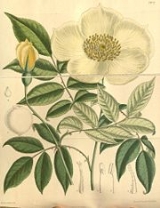
Rosa gigantea
Encyclopedia
Rosa gigantea is a species of rose
native to northeast India
, northern Myanmar
and southwest China
(Yunnan
) in the foothills of the Himalaya at 1000–1500 m altitude. As its name suggests, it is the largest species of rose, climbing 20 m or more into the crowns of other tree
s by means of its stout, hooked thorns, and with a trunk up to 50 cm diameter. The leaves
are semi-evergreen, 15–25 cm long, pinnate, with usually 7 leaflets, each leaflet 4–8 cm long. The flower
s are white, creamy or yellow, the largest of any wild rose, 10–14 cm diameter. The hips
are yellow or orange, 2.5-3.5 cm diameter, hard, and often lasting through the winter into the following spring, often still present at the same time as the next years' flowers.
Another rose, described from Manipur
in 1888 as R. macrocarpa and R. xanthocarpa by Sir George Watt, an authority on India
n rose
s, is now generally considered to be the same species as R. gigantea. The distinct characteristics claimed for R. macrocarpa (deeper yellow flowers, larger foliage with 4 to 7 leaflets and large yellow fruits) are not consistent.
Rose
A rose is a woody perennial of the genus Rosa, within the family Rosaceae. There are over 100 species. They form a group of erect shrubs, and climbing or trailing plants, with stems that are often armed with sharp prickles. Flowers are large and showy, in colours ranging from white through yellows...
native to northeast India
India
India , officially the Republic of India , is a country in South Asia. It is the seventh-largest country by geographical area, the second-most populous country with over 1.2 billion people, and the most populous democracy in the world...
, northern Myanmar
Myanmar
Burma , officially the Republic of the Union of Myanmar , is a country in Southeast Asia. Burma is bordered by China on the northeast, Laos on the east, Thailand on the southeast, Bangladesh on the west, India on the northwest, the Bay of Bengal to the southwest, and the Andaman Sea on the south....
and southwest China
China
Chinese civilization may refer to:* China for more general discussion of the country.* Chinese culture* Greater China, the transnational community of ethnic Chinese.* History of China* Sinosphere, the area historically affected by Chinese culture...
(Yunnan
Yunnan
Yunnan is a province of the People's Republic of China, located in the far southwest of the country spanning approximately and with a population of 45.7 million . The capital of the province is Kunming. The province borders Burma, Laos, and Vietnam.Yunnan is situated in a mountainous area, with...
) in the foothills of the Himalaya at 1000–1500 m altitude. As its name suggests, it is the largest species of rose, climbing 20 m or more into the crowns of other tree
Tree
A tree is a perennial woody plant. It is most often defined as a woody plant that has many secondary branches supported clear of the ground on a single main stem or trunk with clear apical dominance. A minimum height specification at maturity is cited by some authors, varying from 3 m to...
s by means of its stout, hooked thorns, and with a trunk up to 50 cm diameter. The leaves
Leaf
A leaf is an organ of a vascular plant, as defined in botanical terms, and in particular in plant morphology. Foliage is a mass noun that refers to leaves as a feature of plants....
are semi-evergreen, 15–25 cm long, pinnate, with usually 7 leaflets, each leaflet 4–8 cm long. The flower
Flower
A flower, sometimes known as a bloom or blossom, is the reproductive structure found in flowering plants . The biological function of a flower is to effect reproduction, usually by providing a mechanism for the union of sperm with eggs...
s are white, creamy or yellow, the largest of any wild rose, 10–14 cm diameter. The hips
Rose hip
The rose hip, or rose haw, is the fruit of the rose plant, that typically is red-to-orange, but ranges from dark purple to black in some species. Rose hips begin to form in spring, and ripen in late summer through autumn.-Usage:...
are yellow or orange, 2.5-3.5 cm diameter, hard, and often lasting through the winter into the following spring, often still present at the same time as the next years' flowers.
Another rose, described from Manipur
Manipur
Manipur is a state in northeastern India, with the city of Imphal as its capital. Manipur is bounded by the Indian states of Nagaland to the north, Mizoram to the south and Assam to the west; it also borders Burma to the east. It covers an area of...
in 1888 as R. macrocarpa and R. xanthocarpa by Sir George Watt, an authority on India
India
India , officially the Republic of India , is a country in South Asia. It is the seventh-largest country by geographical area, the second-most populous country with over 1.2 billion people, and the most populous democracy in the world...
n rose
Rose
A rose is a woody perennial of the genus Rosa, within the family Rosaceae. There are over 100 species. They form a group of erect shrubs, and climbing or trailing plants, with stems that are often armed with sharp prickles. Flowers are large and showy, in colours ranging from white through yellows...
s, is now generally considered to be the same species as R. gigantea. The distinct characteristics claimed for R. macrocarpa (deeper yellow flowers, larger foliage with 4 to 7 leaflets and large yellow fruits) are not consistent.

